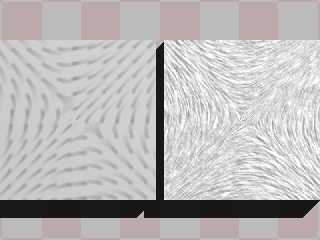|
 |
I was surprised a newsgroup search didn't turn up anything for this. I'm
planning to use this technique for an animation I'm doing as my final project
for a Scientific Visualization course, so I don't have time to get the code into
a form more suitable for general use. Perhaps someone might find it useful as it
is.
http://en.wikipedia.org/wiki/Line_integral_convolution
/* Line Integral Convolution Demonstration
*
* A line integral convolution is often used to visualize flows.
* It effectively "smears" an underlying pattern along flowlines.
* The flowlines are computed by gradient descent.
* This would be better implemented internally as a warp.
*
povray +P +RP1 lic.pov
*/
#version 3.7;
global_settings {
assumed_gamma 1.0
ambient_light 0.1
}
#include "functions.inc"
#include "stage1.inc"
#declare Show_Gradient = 2;
#switch(Show_Gradient)
#case(1)// Gradient of x^2+y^2+z^2
#declare F_gradx = function(X,Y,Z){(2*X )};
#declare F_grady = function(X,Y,Z){(2*Y )};
#declare F_gradz = function(X,Y,Z){(2*Z )};
#break
#case(2)// Saddle Point
#declare F_gradx = function(X,Y,Z){-Y/sqrt(pow(X,2)+pow(Y,2))};
#declare F_grady = function(X,Y,Z){-X/sqrt(pow(X,2)+pow(Y,2))};
#declare F_gradz = function(X,Y,Z){0};
#break
#end
// Gradient Length
#declare F_gradl = function(X,Y,Z){
sqrt(
pow(F_gradx(X,Y,Z),2)
+pow(F_grady(X,Y,Z),2)
+pow(F_gradz(X,Y,Z),2)
)
};
// Normalized Gradient
#declare F_granx = function(X,Y,Z){F_gradx(X,Y,Z)/F_gradl(X,Y,Z)};
#declare F_grany = function(X,Y,Z){F_grady(X,Y,Z)/F_gradl(X,Y,Z)};
#declare F_granz = function(X,Y,Z){F_gradz(X,Y,Z)/F_gradl(X,Y,Z)};
#declare LIC_F_Pattern = function(X,Y,Z){(
f_granite(X/10,Y/10,Z/10) //Best?
//f_leopard(X/2,Y/2,Z+.5)*(f_leopard(X/2,Y/2,Z+.5)>0.5)
//(f_noise3d(X,Y,Z)>0.8)
//f_noise_generator(X,Y,Z, 1)
//f_spotted(X,Y,Z)//>0.5
//f_crackle(X,Y,Z)*(f_crackle(X,Y,Z)>0.5)
//f_dents(X,Y,Z)
//f_bozo(X,Y,Z)
//f_wrinkles(X,Y,Z)// Good
)};
// Convolution Envelopes
#declare LIC_F_Constant = function(M,N){ 1 };
#declare LIC_F_Ramp_Down = function(M,N){ (1-M/N)*2 };
#declare LIC_F_Ramp_Up = function(M,N){ M/N*2 };
//Line Integral Convolution Pattern Functions
#declare LIC_F_Forward = function(x,y,z, S,H,N){
sum(M,0,N-1,
LIC_F_Ramp_Down(M,N)
*LIC_F_Pattern(
(x+H*sum(I,0,M,F_granx((x+H*I),y,z)))/S,
(y+H*sum(I,0,M,F_grany(x,(y+H*I),z)))/S,
(z+H*sum(I,0,M,F_granz(x,y,(z+H*I))))/S
))/N
};
#declare LIC_F_Backward = function(x,y,z, S,H,N){
sum(M,0,N-1,
LIC_F_Ramp_Down(M,N)
*LIC_F_Pattern(
(x+H*sum(I,0,M,F_granx((x-H*I),y,z)))/S,
(y+H*sum(I,0,M,F_grany(x,(y-H*I),z)))/S,
(z+H*sum(I,0,M,F_granz(x,y,(z-H*I))))/S
))/N
};
#declare REFLECTION = 0.25;
#declare ROUGHNESS = 0.05;
#declare Some_Finish = finish{ reflection REFLECTION
diffuse 0.6 * (1 - REFLECTION)
ambient 0.1 * (1 - REFLECTION)
roughness ROUGHNESS
#switch (2)
#case (1) specular 0.25 * ((1/ROUGHNESS)+1) * REFLECTION #break
#case (2) specular albedo REFLECTION #break
#end
};
//---------------------- Right Box ------------------------
#local LIC_Scale = 0.03 ;// Scale the pattern.
#local LIC_Length = 10 *LIC_Scale;// Total length of contour
#local LIC_Samples= 20 ;// Number of samples along the contour
#local LIC_Step = LIC_Length/LIC_Samples;
box{<-2,-2,0>,<2,2,1>
texture{
pigment{
color srgb<1,1,1>
}
normal{
function{ LIC_F_Backward(x,y,z+Show_Gradient-1,
LIC_Scale, LIC_Step, LIC_Samples) }
0.25
}
finish{Some_Finish}
}//end texture
translate 2.1*x
}
//--------------------- Left Box ------------------------
#declare LIC_F_Leopard = function(X,Y,Z, Threhshold){(
f_leopard(X,Y,Z)*(f_leopard(X,Y,Z)>Threhshold)
)};
#declare LIC_F_Backward_2 = function(x,y,z, S,H,N){
sum(M,0,N-1,
LIC_F_Ramp_Down(M,N)
*LIC_F_Leopard(
(x+H*sum(I,0,M,F_granx((x-H*I),y,z)))/S,
(y+H*sum(I,0,M,F_grany(x,(y-H*I),z)))/S,
(z+H*sum(I,0,M,F_granz(x,y,(z-H*I))))/S, 0.6
))/N
};
#local LIC_Scale = 0.06 ;// Scale the pattern used.
#local LIC_Length = 10 *LIC_Scale;// Total length of contour
#local LIC_Samples= 20 ;// Number of samples along the contour
#local LIC_Step = LIC_Length/LIC_Samples;
box{<-2,-2,0>,<2,2,1>
texture{
pigment{
function{1-2*LIC_F_Backward_2(x,y,z+Show_Gradient-1,
LIC_Scale,LIC_Step,LIC_Samples)}
}
finish{Some_Finish}
}//end texture
translate -2.1*x
}
Post a reply to this message
Attachments:
Download 'lic.png' (251 KB)
Preview of image 'lic.png'

|
 |




![]()